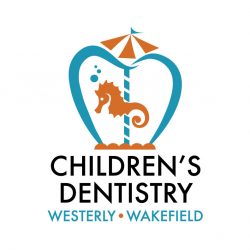CHILDREN'S DENTISTRY OF WESTERLY & WAKEFIELD
Preventative Care for Children's Dental Health

Tooth Brushing and Flossing Instructions for Your Infants and Toddlers
Children’s hands and mouths are different than adults. They need to use toothbrushes designed for children. Both adults and children should use brushes with soft, rounded bristles for gentle cleaning. Change to a new brush about every three months.
When should you begin brushing your child’s teeth?
Once your child’s teeth begin erupting, you can begin cleaning them. Talk with our staff at Children’s Dentistry in Westerly or Children’s Dentistry in Wakefield about the best approach for your child. Most children cannot fully spit until they are 4 or 5 years old. Speak with our staff about fluoride-free versus fluoridated toothpaste for your child. Once teeth start to touch each other as they grow, flossing is just as important as brushing!
When can children start to brush their own teeth?
Home dental care is a team effort! Let’s go team! Your child may brush his or her teeth when it feels comfortable and fun for them, but you will still need to brush where they miss.
A good rule of thumb is this: if your child cannot tie their shoes by themselves, then they cannot brush by themselves just yet.
Ideas to Make Brushing Fun for Kids!
You may be wondering… just how do I make brushing teeth fun for my kids? For some toddlers and young children, getting them to brush their teeth can be quite a challenge! Here are some suggestions for making tooth brushing less of a battle:
Let your child pick out a few toothbrushes with his or her favorite characters or colors/styles and give them a choice of which one to use!
Take turns brushing your child’s teeth with them
- Consider using a Tooth Brush Timer video!
- Read some children’s books about tooth brushing!
Cavity Prevention for Young Children
What is "baby-bottle" tooth decay?
Babies who go to bed with a bottle of milk, formula or juice are more likely to get tooth decay. This can also be seen when a child sleeps in bed with the mother and nurses “at will” all night. Because the sugar in formula, milk or juice stays in contact with the teeth for a long time during the night, the teeth can decay quickly.
Tips to avoid baby-bottle tooth decay
- Put your child to bed with a bottle of plain water, not milk or juice. Or better yet, no bottle in bed!
- Stop nursing when your child is asleep or has stopped sucking on the bottle.
- Try not to let your child walk around using a bottle of milk or juice as a pacifier.
- Start to teach your child to drink from a cup at about 6 months of age. Plan to stop using a bottle by 12 to 14 months at the latest.
- Don’t dip your child’s pacifier in honey or sugar.
Remember, the bottle is to feed your child, not pacify him. The more it is a pacifier, the more he or she wants it, the greater the risk of this aggressive tooth decay.
Long-Term Cavity Prevention
What causes cavities?
Most of the time cavities are due to a diet high in sugary foods and beverages, as well as a lack of proper oral hygiene. Limiting sugar intake and brushing and flossing regularly can help. The longer it takes your child to eat their foods the longer the food residue stays on their teeth, and the greater the chances of getting cavities.
Consistency of a person’s saliva also makes a difference; thinner saliva breaks up and washes away food more quickly. When a person eats diets high in carbohydrates and sugars they tend to have thicker saliva, which allows for a higher level of acid producing bacteria that will eventually cause cavities. Also, saliva flow goes down as you sleep, so only offer water when they wake up in the middle of the night, not juice.
Tips for cavity prevention:
- Encourage, and assist if needed, brushing, flossing and rinsing
- Watch what your child drinks
- Avoid sticky foods
- Limit frequency of meals and snacks (avoid the grazing habit)
- Give treats in moderation and make them part of meals
- Choose nutritious snacks
Sealants: What Are They and Why Are They Recommended?
What are sealants?
Sealants refer to a white resin material that is bonded into the grooves of the chewing surface on molars as a means of helping to prevent the formation of tooth decay. These grooves are especially deep on permanent molars and have historically been a common area of tooth decay. When a sealant is applied, these grooves are filled in, and the surface of the tooth becomes flatter and smoother. Since plaque can be removed more easily and effectively, there is much less chance that decay will start.
What teeth need to be sealed?
Any tooth that has deep grooves and is hard to clean with regular tooth brushing should be sealed. The most common teeth that we seal are the permanent first and second molars. However, we will recommend sealants based upon a case-by-case basis. A child who is prone to tooth decay may benefit from sealing other permanent teeth such as premolars.
How long does the sealant process take?
Generally, the sealant procedure takes one visit. Placing dental sealants can be a very easy process. The tooth is cleaned, conditioned and dried. The sealant is then flowed onto the grooves of the tooth where it is hardened with a special blue light.
How long will my child's sealants last?
The longevity of sealants can vary. Sealants that have remained in place for three to five years would be considered successful; however, sealants can last much longer. Our team at Children’s Dentistry of Westerly and Wakefield will check your child’s sealants during routine dental visits and will recommend repair or reapplication when necessary.
Do you still need to brush and floss after getting sealants?
Yes, absolutely. It is just as important for your child to brush and floss after sealants are placed.
Preventing Periodontal "Gum" Disease
Can kids get gum disease and gingivitis?
While many people believe periodontal disease is an adult problem, studies indicate that gingivitis (the first stage of periodontal disease) is nearly a universal problem among children and adolescents. Advanced forms of periodontal disease are more rare in children than adults, but can occur.
See the article: “Children at Risk for Gum Disease”
How does gingivitis affect children?
Chronic gingivitis is common in children. It can cause gum tissue to swell, turn red and bleed easily. Gingivitis is preventable and treatable with a regular routine of brushing, flossing and professional dental care. If left untreated, it can eventually advance to more serious forms of periodontal disease. Check your child’s mouth for the signs of periodontal disease, including bleeding gums, swollen and bright red gums, or gums that are receding away from the teeth and bad breath.
Does gum disease and gingivitis go away as kids get older?
There is evidence that suggests periodontal (“gum”) disease may increase during the teenage years due to the lack of motivation to practice ideal oral health by some children. Children who maintain good oral health habits up until the teen years are more likely to continue brushing and flossing than children who were not taught proper oral care. If your child currently has poor oral health habits, work with your child to change these now. It’s much easier to modify these habits in a child than in a teenager. Since your child models behavior after you, it follows that you should serve as a positive role model in your oral hygiene habits. A healthy smile, good breath and strong teeth all contribute to a young person’s sense of personal appearance, as well as confidence and self-esteem.
The Importance of Fluoride for Your Children's Teeth
Does my child need fluoride?
Yes. Fluoride helps make teeth strong and prevents tooth decay. With over 20 years of experience in the southern Rhode Island/Southeastern Connecticut area, our team at Children’s Dentistry in Westerly and Children’s Dentistry in Wakefield have become “specialists” in the many different water sources in this area. A town water source could be fluoridated, non-fluoridated, or on a community well. In addition, individual homes may be on their own well water system.
How will I know if my child is getting the fluoride they need?
At your first visit we will discuss your particular fluoride needs, and prescribe fluoride supplements (fluoride drops or pills) if indicated. You give these drops or pills every day, starting when your child is 6 months of age. The dose will change throughout childhood and is discontinued once all adult teeth erupt. Please remember if you move to a new home let us know, as your fluoride needs may change at the new address. Remember, we are always available to answer any questions you may have regarding the appropriateness of fluoride for your child.
Does My Child Need a Mouth Guard for Sports?
Here at Children’s Dentistry of Westerly and Wakefield, we certainly recommend mouth guards for youth sports or other highly physical activities that your child participates in.
How do I choose the right mouth guard?
Choose a mouth guard that your child feels is comfortable. If a mouth guard feels bulky or interferes with speech to a great degree, it is probably not appropriate for your child. There are many options in mouth guards. Most mouth guards can be easily found in athletic stores. These vary in comfort, protection, and cost. Customized mouth guards can be provided through our practice as well. Speak with our team at Children’s Dentistry of Westerly and Wakefield about the most appropriate mouthguard for your child.

